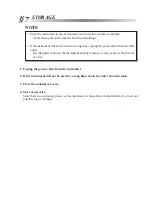
5 - 7
5.4 Storing and Calling Up Traced Data (built-in memory)
The edger is provided with a memory function, which stores traced data and lens layout data in
their memory and calls them up whenever necessary. By storing a repetitive lens outline as
standard data and calling it up with the function, the operator does not have to trace the same
lens for each processing and can save time required for lens processing. In addition, even if a
frame is not available, it is possible to process the lens as soon as it is ready. The memory holds
up to 100 sets of the traced and layout data at most. The use of the optional barcode scanner
extends the storable number of data up to 500 sets of data.
CAUTION
• When a lens is to be edged using data called up from the memory, perform edging after
checking the traced outline on the screen.
When called data is abnormal, the error code (Error 0906) will be shown. Restore
the data without processing.
NOTE
• Concurrent use of the communication function and memory function is impossible.
Only when the parameter “Ext. interface” is set at “None”, the memory function becomes
available.
• The stored data is battery-protected even if the power has been turned OFF.
Since this battery is rechargeable, the battery becomes empty and the stored data
may be lost if the instrument is not used for a long time (about one month) or soon
after the instrument is purchased. In this case, turn ON the power of the main body
and charge the battery. For full-charging, it is necessary to keep the power ON for 15
hours.
If power is supplied to the instrument for one hour or more everyday after full-
charging, the battery becomes almost fully charged. If the instrument is used for a
short time, keep the power of the instrument ON for several hours once a month.
Summary of Contents for LE-9000DX Express
Page 1: ...NIDEK PATTERNLESS EDGER LE 9000EX Express LE 9000DX Express OPERATOR SMANUAL...
Page 17: ...2 9 or or Top view...
Page 19: ...2 11...
Page 153: ......
































